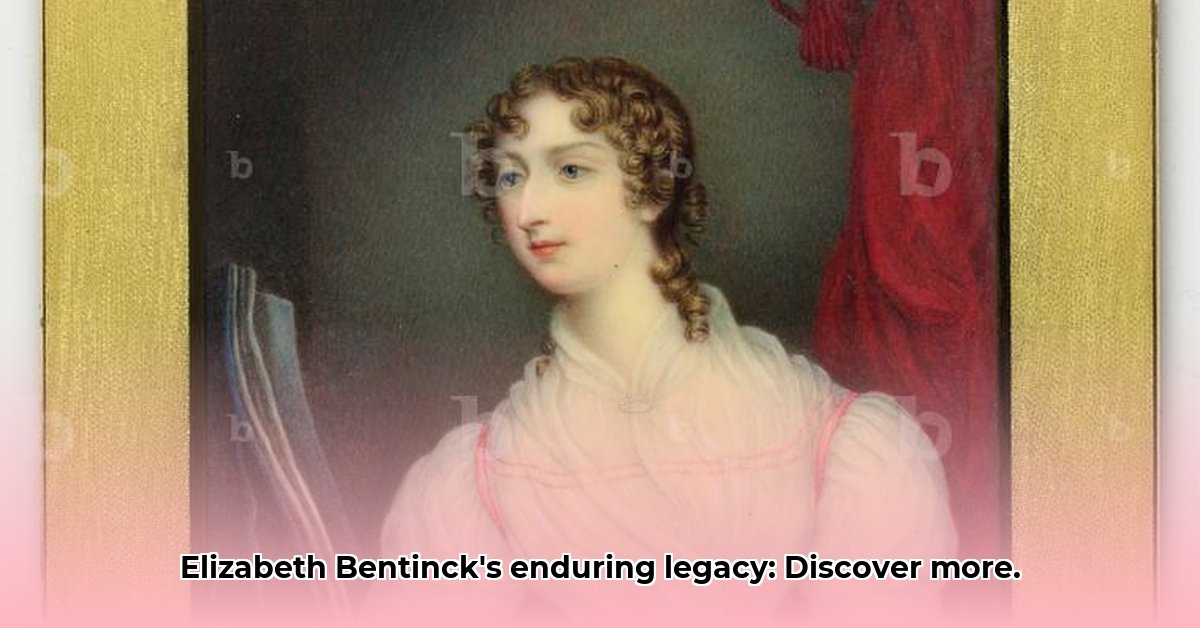Ever heard of Elizabeth Bentinck? Probably not, but she made a real difference. While hard figures are elusive, her story centers on the tangible impact she had on women, the environment, and education. This isn’t just revisiting historical facts; it’s understanding her methods, their effectiveness, and why her approach to charity remains relevant. For more details on her life and work, see her contributions. We’ll explore her personal involvement, her long-term dedication, and how her thoughtful strategies continue to inspire meaningful ways to give back. Prepare to discover valuable lessons about creating lasting change, learned from a woman whose work continues to resonate.
How Elizabeth Bentinck is Remembered Today: Philanthropy and Enduring Change
Elizabeth Bentinck: the name may not be universally recognized, but her influence continues to resonate. How do we remember her? Not necessarily through extensive statistical data – historical records aren’t always complete – but through the enduring legacy of her actions. She was more than a philanthropist writing checks; she was deeply committed to fostering lasting change in education, environmental protection, and women’s empowerment. Visualize her not merely donating funds, but building the foundations for a more equitable future.
Her approach to philanthropy was uniquely personal, a stark contrast to today’s more transactional approaches. Instead of merely funding initiatives, she actively engaged, building strong relationships with the people and organizations she supported. This personalized element distinguishes her work and contributes to her enduring legacy.
Quantifying her achievements precisely is difficult. Historical records of the period are incomplete, hindering definitive impact measurements. However, focusing solely on numbers overlooks the broader picture. Her legacy lies in the nature of the change she fostered. Consider the potential ripple effect: her direct involvement likely motivated many others, leading to a broader, immeasurable, yet undoubtedly significant positive impact. While documenting the exact number of lives she touched directly is impossible, the depth of her commitment speaks volumes.
What can today’s philanthropists learn from her example? Plenty. Bentinck’s story provides a compelling lesson in personalized engagement, sustained commitment, and strategic planning. She recognized that lasting impact stems from personal involvement and sustained effort, not solely from financial contributions. She actively shaped the initiatives she supported, ensuring their long-term success, a stark contrast to simply handing over funds. This prompts a crucial question: Is effective philanthropy solely about the amount donated, or is it equally about the commitment and personal engagement behind it?
Bentinck’s dedication went far beyond financial contributions. Her hands-on approach is clearly demonstrated in her environmental conservation efforts. She didn’t just provide funding for eco-friendly projects; she actively participated in their execution, ensuring environmentally sound and sustainable practices. She understood the interconnectedness of complex problems, addressing environmental issues, educational limitations, and gender inequality as elements of a broader strategy for generating positive change.
Her steadfast dedication to women’s empowerment deserves particular recognition. She seemed to view empowering women as crucial for broader societal advancement. She championed women’s potential, providing sustained opportunities and mentorship, in addition to financial support. This holistic vision – combining environmental stewardship, educational advancement, and women’s rights – provides a strikingly relevant blueprint for contemporary philanthropy.
Despite limitations in historical records, Elizabeth Bentinck’s lasting legacy is undeniable. She stands as a pioneer of strategically focused, deeply personal philanthropy. Her commitment to long-term impact and direct engagement continues to inspire philanthropic practices today. Perhaps her key lesson is the profound importance of intentionality and unwavering dedication. Her life’s work serves as a testament to the transformative potential of focused, engaged philanthropy—a legacy that continues to resonate in our world. Ongoing research into her work continues to uncover details about her methods and their impact, revealing her influence may be even greater than we currently understand. Her story encourages us to consider not only the “how much,” but also the “how” and the “why” of charitable giving.
How to Measure the Qualitative Impact of Historical Philanthropy: Elizabeth Bentinck’s Enduring Legacy and Charitable Work
Key Takeaways:
- Though extensive quantifiable data is lacking, Elizabeth Bentinck’s philanthropic efforts delivered a significant qualitative impact, transforming conventional understanding of charitable foundations.
- Assessing the qualitative impact of historical philanthropy involves exploring personal involvement, sustained commitment, and strategic focus on key areas, such as environmental protection.
- Her contributions to education, environmental stewardship, and women’s empowerment continue to resonate, emphasizing the importance of women’s leadership.
Unveiling Elizabeth Bentinck’s Enduring Influence
How do we determine the value of a life dedicated to selfless service when precise figures are unavailable? This challenge arises when studying figures like Elizabeth Bentinck, whose impactful philanthropy has profoundly shaped lives, but left behind limited quantifiable records. We must go beyond simply counting beneficiaries and explore deeper dimensions.
Elizabeth Bentinck’s story doesn’t center on easily calculated donations, but rather on sustained dedication and strategic vision. Her influence wasn’t solely about financial contributions; it was about the enduring ripple effect, shaping our understanding of methods for evaluating the qualitative impact of historical philanthropy.
The Qualitative Lens: Beyond the Numbers
Discard spreadsheets and balance sheets momentarily. When examining Bentinck’s legacy, our focus shifts to qualitative aspects. What methods did she employ? What were her key priorities? How did she cultivate sustained partnerships? And what lasting changes did she successfully initiate? These questions provide a framework for evaluating her enduring impact.
Consider her commitment to education. Did she simply donate funds? Or did she take an active role in selecting educators, shaping curriculum, and ensuring access for marginalized communities? This degree of engagement signifies a significant qualitative contribution, often overlooked in purely quantitative assessments.
Similarly, her environmental stewardship extends beyond mere land ownership. Her mindful approach to responsible resource management, her dedication to environmental conservation, and her advocacy for sustainable practices define her enduring influence.
Capturing the Intangibles: Methods for Measuring Qualitative Impact
How do we measure the qualitative impact of historical philanthropy in situations like Bentinck’s? Consider these crucial strategies:
- Archival Research: Investigate primary sources, including letters, diaries, and news articles, to gain deeper insights into her motivations, strategies, and interactions.
- Oral Histories: If possible, collect personal accounts from individuals whose lives were positively influenced by her actions or the institutions she supported.
- Comparative Analysis: Compare Bentinck’s philanthropic approach to contemporary strategies. Which aspects of her methods remain relevant and effective today?
- Legacy Assessment: Identify institutions, programs, or social changes that directly resulted from her engagement and sustained efforts.
These strategies allow for a richer, more comprehensive understanding—a picture far more vivid than mere numbers could capture.
The Lasting Resonance: Relevance to Modern Philanthropy
Bentinck’s story provides lasting lessons for today’s philanthropists. Her life serves as an important reminder that true influence expands beyond monetary contributions, encompassing dedication, strategic perspective, and the long-term vision to foster impactful change. Her emphasis on education and empowering women remains remarkably relevant. Her legacy inspires critical thinking on measuring the qualitative impact of historical philanthropy.
By emphasizing qualitative analysis, we gain a deeper appreciation for the impactful contributions of historical figures like Elizabeth Bentinck and develop a more comprehensive understanding of their durable legacies. Her story challenges contemporary philanthropists to consider the intangible aspects of their charitable giving, realizing that true impact is often interwoven into the fabric of changed lives.
Elizabeth Bentinck’s Influence on Environmental Conservation Strategies and Social Responsibility
Key Takeaways:
- Elizabeth Bentinck’s philanthropic efforts played a significant role in environmental conservation, even though precise details are limited.
- Her life exemplifies a commitment to responsible land management, sustainable practices, and heightened environmental awareness.
- Although quantifiable data is sparse, the qualitative impact of her work is evident, providing continued inspiration for future generations.
A Modern Aristocrat’s Vision
Elizabeth Mary Wilhelmina Bentinck wasn’t a typical aristocrat. While her lineage connected her to a world of tradition, her actions demonstrated a forward-thinking commitment to social and environmental progress. She was not satisfied with simply maintaining the status quo; she actively participated in shaping a better future. How did she achieve this? Through sustained dedication, effective philanthropy, and belief in the power of education. This combination fueled her positive influence, particularly in environmental conservation strategies. But how did she leave her mark on conservation projects?
Limited Records, Lasting Impact
Unfortunately, detailed records documenting all her initiatives are unavailable. However, existing accounts of her life provide evidence of a sustained engagement with critical environmental issues. This engagement extended beyond simply writing checks; she actively participated in diverse initiatives. We gain glimpses of her far-reaching contributions through fragmented stories, each piece adding depth to an inspiring narrative, even though incomplete. Her overall impact resonates across the decades, though measurable less precisely than we might like. This lack of documented evidence makes determining the precise scope of Elizabeth Bentinck’s Influence on Environmental Conservation Strategies somewhat challenging. However, the available information remains compelling.
Beyond the Numbers: A Legacy of Stewardship
Consider this perspective: although we may not know the specific number of trees she planted, we know she enthusiastically championed sustainable













